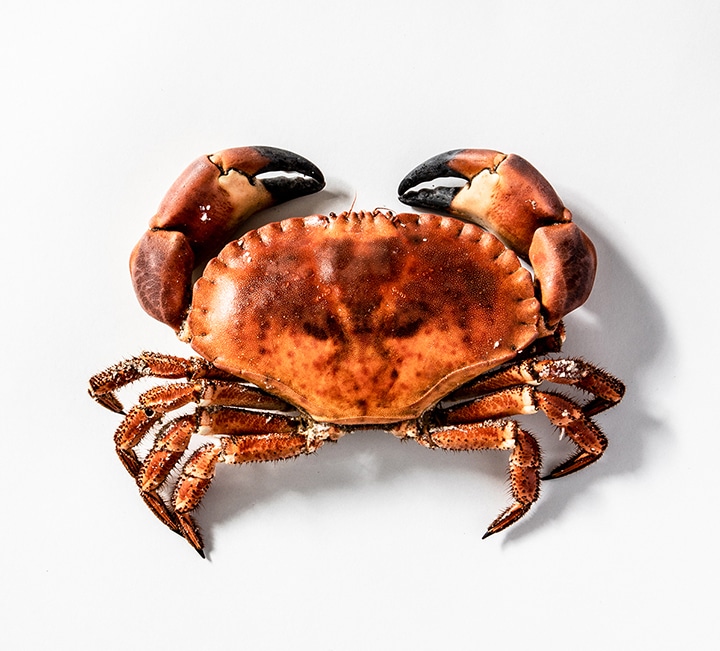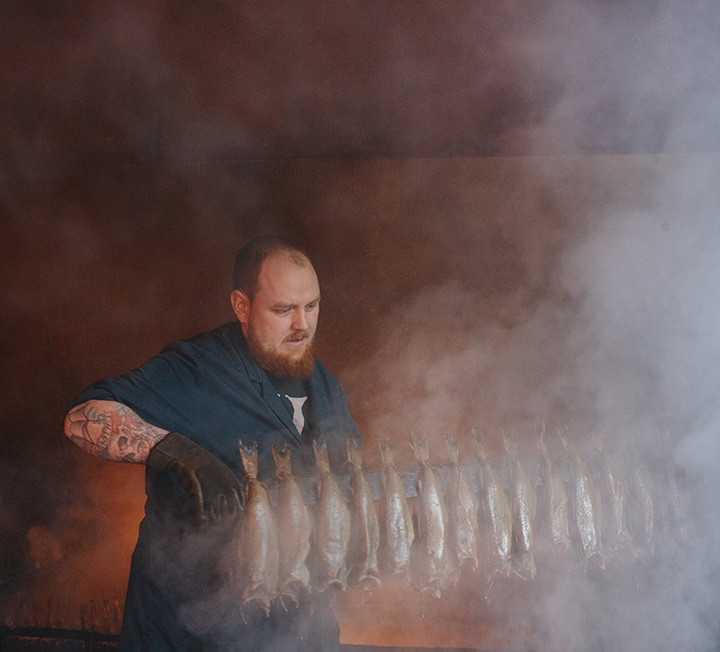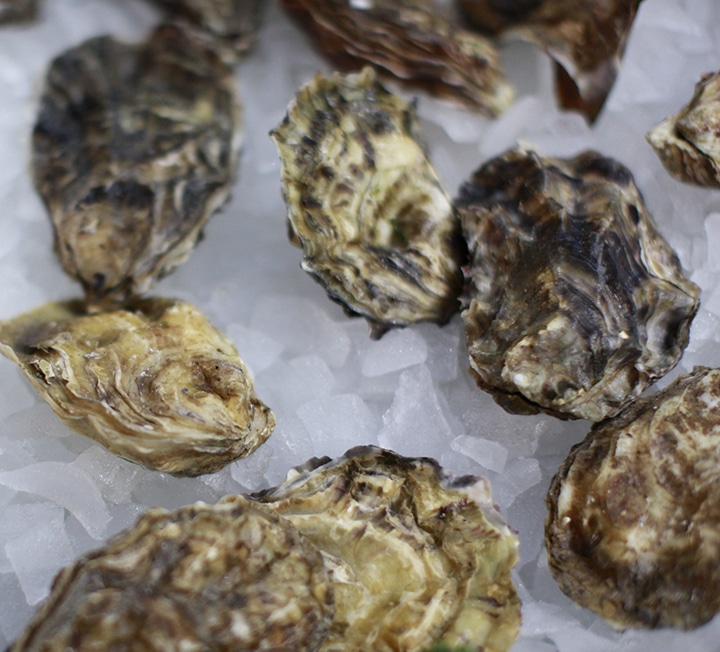Deep and meaningful
Clare Finney heads out into the English Channel to watch Darren Brown of Shellseekers Fish & Game engaging in the age-old art of scallop diving – a method of collection that helps sustain the delicate ecosystem of the seabed
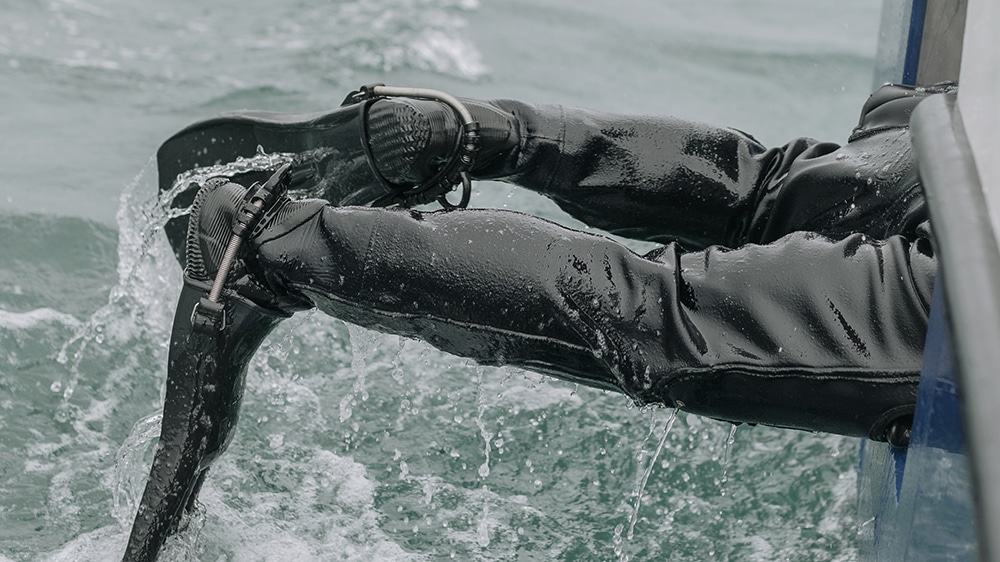

“IF THIS WAS HAPPENING ON LAND, WHERE PEOPLE COULD SEE THE HAVOC THEY CAUSE, THEY’D STOP IT IMMEDIATELY”
Images: Orlando Gili
“Sometimes it is like looking under your bed for a pair of socks, the visibility’s that poor. If the tide is strong it’s so gloomy, you can end up bumping into things.” Other times, expert scallop diver Darren Brown of Shellseekers Fish & Game can spend a full hour and 40 minutes picking what some have likened to solid gold coins off the floor. “It’s a gamble,” he shrugs, checking his watch and putting his foot down, in a van chockful of gadgets and gizmos. Time and tide wait for no man – not even an ex-marine who, when he isn’t diving, is either line fishing or stalking deer and rabbits on Dartmoor; and with a slight kerfuffle over a hole in Darren’s dry-suit this morning (conclusion: it’s fine – “and if it isn’t I’ll know about it soon enough”) the race is on.
We pull up at the docks: the brooding grey arm of the Isle of Portland on one side, the steely grey of Weymouth bay ahead. It’s a formidable looking place, not helped by gloomy skies and the knowledge that, just out of sight on the island, lies one of Britain’s most notorious prisons. Darren’s boat is moored in the old naval base at the foot of the island, “so really I’ve come full circle. This is the base where I served as a marine. It is a bit weird, coming back here,” he acknowledges. “I walked out in 1997.” After 20 years of supplying fish and game to his stall at Borough Market, hunting and fishing have become “a way of life” for him.

“It’s what I do,” he explains, loading a trailer with baskets, his suit and his fins (“Not flippers. Flipper is a dolphin, darling,” he corrects) and setting off to the mooring. Every morning is early, to catch the tide and some scallops or sea bass, and every night a late one, after an evening spent stalking the moors. Darren’s not complaining. “I have turned my passions and interests into a business,” he says – and it’s a successful one, too, in spite of some serious setbacks.
Of course, scallop fishing isn’t easy – at least, not the way Darren does it. Hand-diving only accounts for two per cent of scallops sold in Britain. Most of the scallops you’ll see in the shops will have been dredged, using what are effectively large metal rakes to scrape scallops – and inevitably, a load of other wildlife – off the seafloor.
“If this was on land, where people could see the havoc they cause, they’d stop it immediately. It’s like the moon down there after they’ve been at it. Everything is upside down, there’s no life at all.” It could take years to grow back, “if it ever does”. But attitudes are slowly changing. Here in Dorset, Darren’s vociferous campaigns against dredging have helped in getting it banned from several areas along the Jurassic Coast.
We board the Maddy Moo: still wet and shining from the deep clean she’s received this morning from Jeff Parish, Darren’s able seaman. “You should have seen her last night,” he grins when we comment on her shipshape appearance “after a seven-hour sea bass fishing trip”. They’d met with limited success on the trip: “Those bloody netters, they scoop them all up,” Jeff complains. Like the dredgers scouring the seabed, the trawler boats are the antithesis of the sustainable, man-versus-fish tactic of rod and line fishing. “You can be the best fisherman in the world, but you can’t catch fish if there aren’t any there to be caught.”
Today, though, Darren is hopeful as we chug gently out of the harbour. On the small black screen in the cabin the outline of the sea bed appears in green squiggles, including a huge naval boat sunk deliberately during the first world war to block the harbour entrance and defend it against German submarines. We slip over it easily, and are released into the grey-green plains of the English Channel. The cliffs are cragged and menacing but, as we come to a stop for Darren to slip into the water, the sea slapping the sides of our little boat is slack and peaceful. We’re at the sweet spot: the gap between tides.
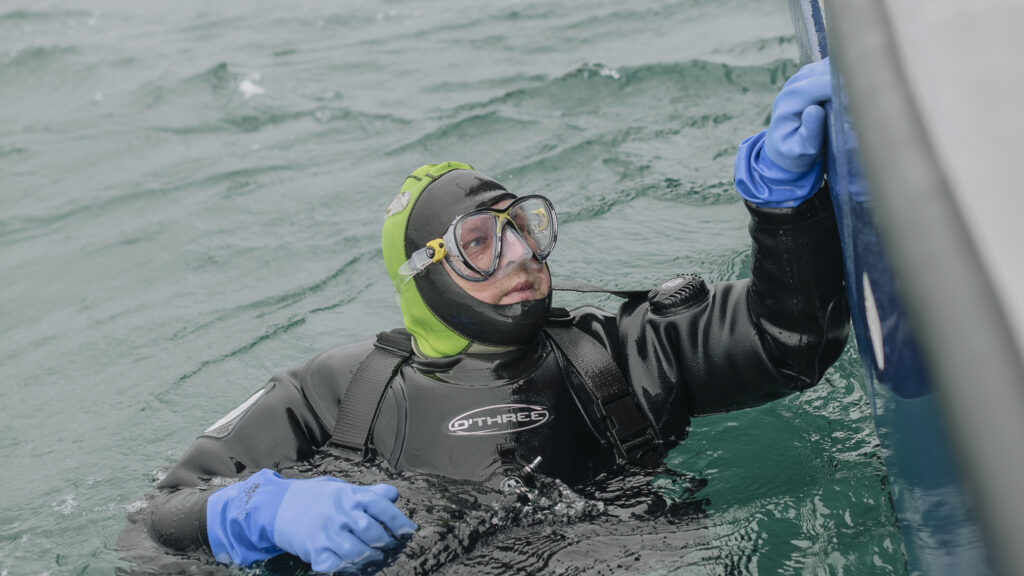
Slip is an understatement. With air cylinders, 32 pounds of weights around his waist and several baskets for collecting scallops, Darren’s entrance into the lolling sea is anything but slow. Even his suit is heavy: a thick, black skin of rubber. On his back, Darren is carrying my entire weight in tank, oxygen and mixed gases. “I’ll be working on 40 per cent oxygen today, which is twice as much oxygen as is in the air. That reduces my exposure to nitrogen which, if it becomes saturated in your blood and doesn’t have a chance to escape as you come up, gives you the bends. It is amazing isn’t it,” he says, fingering his mouthpiece, “that I am reliant on this little bit of rubber to keep me alive.”
In the pocket of his suit, Darren carries a flare. “I’ve been lost at sea for seven hours before. I’m not letting that happen again,” he says grimly. Tied to his belt are the net bags he will fill with scallops then send to the surface, by attaching them to what is effectively an inflatable balloon. He’ll have an hour, he reckons, before the flood of the tide kicks. “I’ve been doing this since I was a teenager. I could go round after someone less experienced and pick up twice as many as they have done. You get what you call the eye, for scallops.” Even while picking up one unwitting shellfish off the sea floor, Darren has one eye scanning the seabed for his next find. A flicker of movement; the flash of an orange frill; even just a slight indentation in the sand can denote a piece of buried treasure.

While Darren is in the deep, Jeff will be manning the boat, keeping his eyes peeled for the inflatable balloons that denote a fresh bag of scallops, and winching them up onto deck with the aid of a small crane.
“I’m going to jump over here captain,” Darren shouts, heaving the cylinders onto his back and diving into the water with surprising ease, if not all that much elegance. Jeff heads to the driver’s seat, ready to guide the boat toward his first find. “When the bag comes up I have to judge which way it’s going to float, and be downwind of it. There is no tide at the moment, so it all hangs on the breeze.” One thing you notice when you spend time with seafarers is how much information they can glean from their environment: the look of the sky, the sound of the sea – even the feel of the winds.
Jeff’s been fishing for as long as he can remember, though he has only recently started making a living from it. “I love the buzz of it,” he explains. As we chat, a red balloon appears about 50 metres away from us, and Jeff starts nudging the boat towards it, reading the wind all the while. Lining the crane up with the bobbing balloon is no mean feat. It appears static, but it’s moving rapidly across the surface and Jeff has to make an informed guess on its speed and distance. He leans over, hooks it to the crane and pulls it on board.
It’s overflowing: scallops, some weedy, some barnacled, all beautiful, spill out across the deck of the ship and Jeff starts sifting and sorting. All the scallops must be graded by size before they can be landed: the statutory minimum size for a king scallop is 100mm, and for a queen it is 40mm. Any smaller than that and they’re to be chucked back into the water, in order that they can continue to grow.
This is the other problem with dredging. Where Jeff and – when he resurfaces – Darren can measure each shell there and then, the dredgers have no such option. While the mesh collector bag attached to the dredge is designed to prevent the collection of undersized scallops, it is inevitable that some get caught up inside. These tiddlers are, eventually, returned to the waters – but there is some doubt over whether they can survive the experience of being dredged.
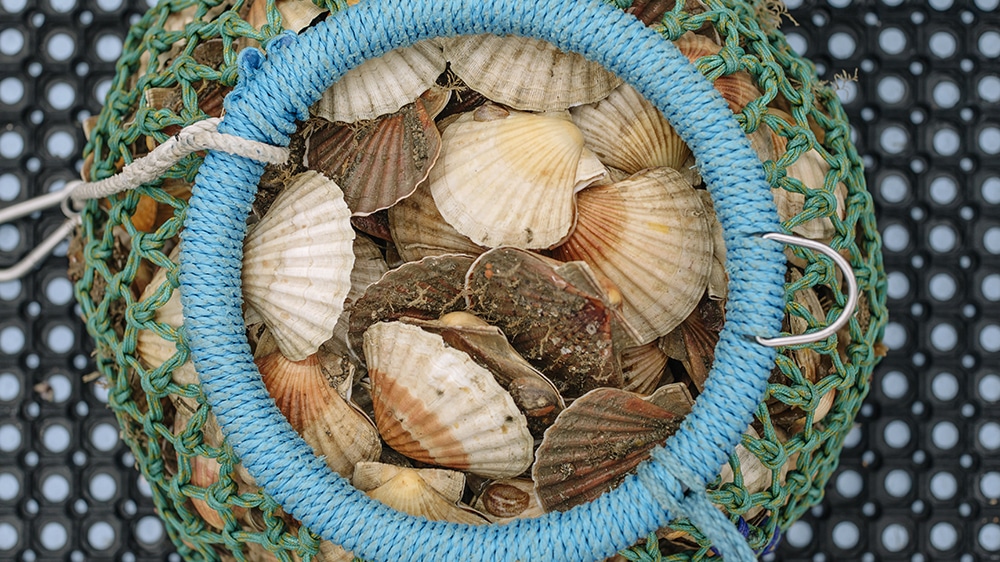
By this point two more balloons have popped up onto the surface – and not before time. “See that? There is a bit of flood kicking in already. He won’t be long now,” Jeff observes, scanning the surface. Eventually he resurfaces: his face triumphant against the steely grey of the water, and we make our way over to him. “There were absolutely stacks down there!” he puffs as Jeff leans down, seizes him by the back of his suit, and hauls him over the side.
Together, the fishermen gather up the last bag of scallops, and start sorting – largely by sight, but using a ruler to check those they’re unsure of. As the Maddy Moo makes her way back to shore, Jeff continues sorting, sending the undersized scallops flying gaily over the side. “Until next year!” I shout silently, as the little shells soar through the air and plop daintily into the sea, in the boat’s wake. In the meantime, we’ve a market to get to – and, as is tradition after a hard day’s work on the water, a swift half to drink.
